ZHCSEG0B November 2015 – April 2017 TMP275-Q1
PRODUCTION DATA.
- 1 特性
- 2 应用
- 3 说明
- 4 修订历史记录
- 5 Pin Configuration and Functions
- 6 Specifications
- 7 Detailed Description
- 8 Application and Implementation
- 9 Power Supply Recommendations
- 10Layout
- 11器件和文档支持
- 12机械、封装和可订购信息
6 Specifications
6.1 Absolute Maximum Ratings
over operating free-air temperature range (unless otherwise noted)(1)| MIN | MAX | UNIT | |
|---|---|---|---|
| Power supply, V+ | 7 | V | |
| Input voltage(2) | –0.5 | 7 | V |
| Input current | 10 | mA | |
| Operating temperature | –55 | 127 | °C |
| Junction temperature, TJ max | 150 | °C | |
| Storage temperature, Tstg | –60 | 130 | °C |
(1) Stresses beyond those listed under Absolute Maximum Ratings may cause permanent damage to the device. These are stress ratings only, which do not imply functional operation of the device at these or any other conditions beyond those indicated under Recommended Operating Conditions. Exposure to absolute-maximum-rated conditions for extended periods may affect device reliability.
(2) Input voltage rating applies to all TMP275-Q1 input voltages.
6.2 ESD Ratings
| VALUE | UNIT | |||
|---|---|---|---|---|
| V(ESD) | Electrostatic discharge | Human-body model (HBM), per AEC Q100-002(1) | ±2500 | V |
| Charged-device model (CDM), per AEC Q100-011 | ±1000 | |||
(1) AEC Q100-002 indicates that HBM stressing shall be in accordance with the ANSI/ESDA/JEDEC JS-001 specification.
6.3 Recommended Operating Conditions
over operating free-air temperature range (unless otherwise noted)| MIN | NOM | MAX | UNIT | |
|---|---|---|---|---|
| Supply voltage | 2.7 | 5.5 | V | |
| Operating free-air temperature, TA | –40 | 125 | °C |
6.4 Thermal Information
| THERMAL METRIC(1) | TMP275-Q1 | UNIT | ||
|---|---|---|---|---|
| D (SOIC) | DGK (VSSOP) | |||
| 8 PINS | 8 PINS | |||
| RθJA | Junction-to-ambient thermal resistance | 121.6 | 185 | °C/W |
| RθJC(top) | Junction-to-case (top) thermal resistance | 70.5 | 76.1 | °C/W |
| RθJB | Junction-to-board thermal resistance | 62 | 106.4 | °C/W |
| ψJT | Junction-to-top characterization parameter | 23 | 14.1 | °C/W |
| ψJB | Junction-to-board characterization parameter | 61.5 | 104.8 | °C/W |
(1) For more information about traditional and new thermal metrics, see the Semiconductor and IC Package Thermal Metrics application report.
6.5 Electrical Characteristics
at TA = –40°C to +125°C and V+ = 2.7 V to 5.5 V (unless otherwise noted)| PARAMETER | TEST CONDITIONS | MIN | TYP | MAX | UNIT | ||
|---|---|---|---|---|---|---|---|
| TEMPERATURE INPUT | |||||||
| Range | –40 | 125 | °C | ||||
| Accuracy (temperature error) | –10°C to 85°C, V+ = 3.3 V | ±0.125 | ±0.75 | °C | |||
| 0°C to 100°C, V+ = 3 V to 3.6 V | ±0.125 | ±1 | |||||
| –40°C to 125°C, V+ = 3 V to 3.6 V | ±0.125 | ±1.5 | |||||
| 25°C to 100°C, V+ = 3.3 V to 5.5 V | ±0.2 | ±2 | |||||
| Resolution(1) | Selectable | 0.0625 | °C | ||||
| DIGITAL INPUT/OUTPUT | |||||||
| Input capacitance | 3 | pF | |||||
| VIH | High-level input logic | 0.7 (V+) | 6 | V | |||
| VIL | Low-level input logic | –0.5 | 0.3 (V+) | V | |||
| IIN | Leakage input current | 0 V ≤ VIN ≤ 6 V | 1 | µA | |||
| Input voltage hysteresis | SCL and SDA pins | 500 | mV | ||||
| VOL | Low-level output logic | SDA | IOL = 3 mA | 0 | 0.15 | 0.4 | V |
| ALERT | IOL = 4 mA | 0 | 0.15 | 0.4 | |||
| Resolution | Selectable | 9 to 12 | Bits | ||||
| Conversion time | 9 bits | 27.5 | 37.5 | ms | |||
| 10 bits | 55 | 75 | |||||
| 11 bits | 110 | 150 | |||||
| 12 bits | 220 | 300 | |||||
| Time-out time | 25 | 54 | 74 | ms | |||
| POWER SUPPLY | |||||||
| Operating range | 2.7 | 5.5 | V | ||||
| IQ | Quiescent current | Serial bus inactive | 50 | 85 | µA | ||
| Serial bus active, SCL frequency = 400 kHz | 100 | ||||||
| Serial bus active, SCL frequency = 3.4 MHz | 410 | ||||||
| ISD | Shutdown current | Serial bus inactive | 0.1 | 3 | µA | ||
| Serial bus active, SCL frequency = 400 kHz | 60 | ||||||
| Serial bus active, SCL frequency = 3.4 MHz | 380 | ||||||
| TEMPERATURE RANGE | |||||||
| Specified range | –40 | 125 | °C | ||||
| Operating range | –55 | 127 | °C | ||||
(1) Specified for 12-bit resolution.
6.6 Timing Requirements
see the Timing Diagrams section for timing diagrams(1)| FAST MODE | HIGH-SPEED MODE | UNIT | |||||
|---|---|---|---|---|---|---|---|
| MIN | MAX | MIN | MAX | ||||
| ƒ(SCL) | SCL operating frequency | V+ | 0.001 | 0.4 | 0.001 | 2.38 | MHz |
| t(BUF) | Bus-free time between STOP and START condition | See the Timing Diagrams section | 1300 | 160 | ns | ||
| t(HDSTA) | Hold time after repeated START condition. After this period, the first clock is generated. |
600 | 160 | ns | |||
| t(SUSTA) | repeated start condition setup time | 600 | 160 | ns | |||
| t(SUSTO) | STOP condition setup time | 600 | 160 | ns | |||
| t(HDDAT) | Data hold time | 4 | 900 | 4 | 120 | ns | |
| t(SUDAT) | Data setup time | 100 | 10 | ns | |||
| t(LOW) | SCL-clock low period | V+ , see the Timing Diagrams section | 1300 | 280 | ns | ||
| t(HIGH) | SCL-clock high period | See the Timing Diagrams section | 600 | 60 | ns | ||
| tFD | Data fall time | See the Timing Diagrams section | 300 | 150 | ns | ||
| tRC | Clock rise time | See the Two-Wire Timing Diagrams section | 300 | 40 | ns | ||
| SCLK ≤ 100 kHz, see the Timing Diagrams section | 1000 | ns | |||||
| tFC | Clock fall time | See the Two-Wire Timing Diagrams section | 300 | 40 | ns | ||
(1) Values are based on a statistical analysis of a one-time sample of devices. Minimum and maximum values are not specified and are not production tested.
6.7 Typical Characteristics
at TA = 25°C and V+ = 5 V (unless otherwise noted)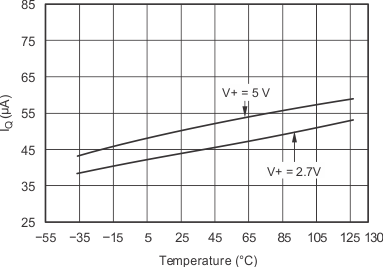
| Serial bus inactive | ||
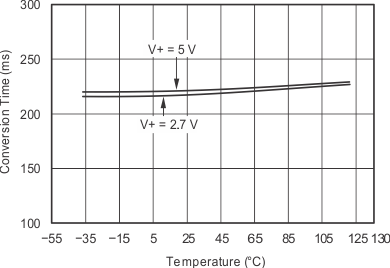
| 12-bit resolution | ||
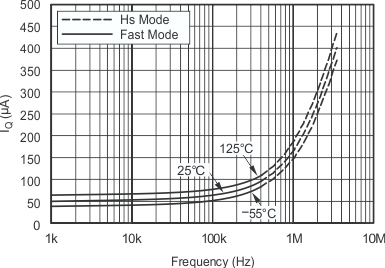 Figure 5. Quiescent Current with Bus Activity
Figure 5. Quiescent Current with Bus Activity vs Temperature
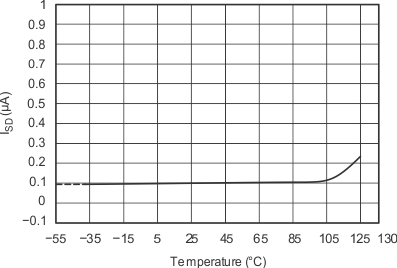
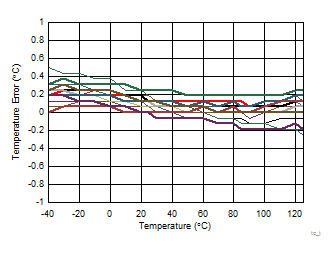
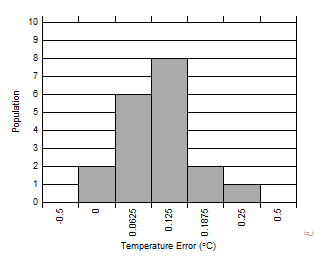 Figure 6. Temperature Error at 25°C
Figure 6. Temperature Error at 25°C